top of page
THe middle east
In November 1914, as an ally of Germany, the Ottoman Empire declared war against France, Russia and Great Britain. Turkey attacked Russian ports. Britain landed troops in Iraq to protect the vital Anglo-Persian oil pipeline. The Central Powers responded with an attack on the British forces at the Suez canal, a vital waterway. Next the British sent warships to the Dardanelle straits to dominate Istanbul, followed by a land force on the Gallipolis peninsula. The defensive Egyptian Expeditionary Force soon became invaders of Ottoman Palestine. Campaigns ensued at Gaza, Be'er Sheva, Jerusalem, Megiddo, and Aleppo, resulting in Ottoman surrender. Tens of thousands of casualties were suffered in these battles. General Edward Allenby's leadership turned the tide for Britain and her allies. Jews joined the ranks of the British, eventually gaining recognition as the 'Jewish Legion'. Meanwhile, local residents suffered great deprivation.
At war's end, Britain occupied Iraq, Transjordan, Palestine, Syria and Lebanon.
Fill in text
 Jewish Troops at Western WallJewish soldiers in the Austrian army, above, and Jewish troops in the British army, below, separately visited the Western wall (Kotel). This is another clear example of the war bringing Jewish brother against brother. | 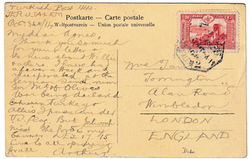 War Breaking Out!This chatty postcard home to London was written on 31 October 1914. He states "War being declared between Turkey and Allies". This actually occurred a little later, but locals in Jerusalem must have seen it coming since Turkey shelled Russian ships on the 28th. Mailed from Jerusalem through the Turkish Post on 31 October 1914. | 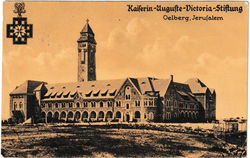 Recovering in JerusalemThe writer mentions that he has a fever and is recovering in a German hospital. It is illustrated on the front of the card: the Augusta Victoria compound which was a Protestant church and hospital founded by Germany on the Mount of Olives in 1907. It continues to serve local Arabs today and is supported by the Lutheran World Federation and the UNRWA. |
|---|---|---|
 Turks shell Russian Black Sea PortThe Ottoman Empire made a secret German alliance on 2 August 1914. On 28 October, German cruisers attached to the Turkish navy shelled the Russian port of Odessa. Following the shelling of Odessa, Russia declared war on the Ottoman Empire on 2 November 1914. The British Navy attacked the Dardanelles on 3 November. Britain and France declared war on 5 November. |  Suez canal viewThe Central Powers made a surprise attack on the Suez Canal in early February 1915. This photo, probably originally taken from a balloon, shows how the Canal connects the Mediterranean Sea to the Red Sea, affording a short passage to the Indian ocean without sailing all the way around the African continent. British and French troops were stationed here to keep the Canal secure. |  Suez Canal MedalThe Suez Canal took 10 years to build and opened in 1869. The builders and majority owners were French, who had a 99 year lease. The Ottomans later agreed that it would be protected by the British who effectively ruled Egypt. This medal shows the Light of Progress addressing the figure of Industry with the legend 'French Economy prepares the Peace of the World'. On the back '17 Nov 1869 the maritime Canal is Open for Grand Navigation'. |
 Attack at Suez Canal"Bedouin attack on English troops at the Suez Canal" reads the caption. The image is an artist's conception of the conflict. This attempt, in early February 1915, to breach British defenses on the Suez Canal and encourage an Islamic revolt in Egypt, failed however, and resulted in heavy losses for the attackers. |  Allenby in JerusalemBritain declared war on Turkey on 5 November 1914. When Ottoman forces attacked the Suez Canal, British forces entered the region. They defended the Canal but were defeated at Gallipolis. Under General Allenby, they conquered Gaza, Beer Sheva, Jerusalem, and the rest of Palestine. |  Anzac Troops in EgyptAustralian and New Zealand Army Corps soldiers were a significant portion of the British troops. They are known as 'ANZAC'. They fought with valor at the Suez Canal and then at Gallipoli Turkey. This envelope of theirs was mailed 11 March 1915 from 'Shepheard's Hotel in Cairo which served as British headquarters during WWI. OHMS stands for 'On His Majesty's Service'. |
 New Zealand memorialThis monument honors the memory of fallen WWI soldiers. The markers that can be read show that those soldiers were part of the NZEF - New Zealand Emergency Force. They fell on 14 November 1917, perhaps in connection with the battles at Gaza. Location of this monument unknown. |  DardanellesOn 28 October the Ottoman empire officially entered the war by bombarding Russian Black Sea ports. This German postcard claims 'Russia opened the hostilities but that Turkey destroyed or damaged Russian ships'. |  Dardanelles.Turks Sink ShipsAfter repeated attempts, the British and French attacked again on 18 March 1915. They fell victim to many Turkish mines set in the straits. This card bears the Turkish flag. In German the caption reads: "The sinking of the English armored cruisers 'Irresistible' and 'Ocean' in front of the Dardanelles". The Allies concluded they would have to bring land forces to the shores. |
 GallipoliThe ANZAC force landed at Gallipoli on 25 April, to open a naval passage to the Black Sea. They met fierce resistance from the Ottoman Army and this attack quickly became a stalemate, and dragged on for 8 months. At the end of 1915, the Allied forces were evacuated. Both sides suffered heavy casualties - the Allied deaths totaled over 56,000, including 8,709 from Australia and 2,721 from N. Zealand. This card commemorates the Lancashire Fusiliers, an infantry regiment in the attack. |  Anzac medal25 April 1915 was the date of the British Anzac forces attack on the Gallipoli peninsula in Turkey. Due to the thousands of troops lost in these attacks, the date became a memorial day for them and other fallen soldiers. This medal was issued by the Victorian Education Department to honor the Australian Imperial Forces on that day in 1918, known as ANZAC Day. It also mentions the three theatres of war in which they were active in WWI. |  WWI.Middle East_edited |
 Gallipoli StarThe defeat of the Allies at Gallipoli was one of the great Ottoman victories of the war. This red star military decoration was created to honor the participants. It continued to be awarded for valor throughout the War. Inside the crescent is the Tugrah symbol of the sultan and his empire, and the Moslem date 1333 = 1915. |  British Gallipolis star medal1690 PTE. J. G. COLLINS, 28/BN. A.I.F. Private John Gerald Collins served in the 28th Battalion of the Australian Imperial Forces. He was 18 years of age when he joined at Perth, Western Australia in May 1915. He was part of the battalion in Gallipoli on 12th October 1915 and received a shell wound to his right leg on 8th December 1915. Britain awarded this medal to all who fought Germany in 1914 - 15. |  Trumpeldor.Zion Mule CorpsJoseph Trumpeldor was a Russian war hero and ardent Zionist. Along with Jabotinsky, he developed the idea of an all-Jewish military unit that would join the British war effort. Russian Jews had fled Palestine or been exiled to Egypt. They were recruited into the 'Zion Mule Corps', a supply unit that brought food water & ammunition to the front - as foreign nationals they were forbidden to join the actual combat. Captain Trumpeldor was second in command under Lt. Colonel John Patterson. |
 Mail From Zion Mule CorpsThe Zion Mule Corps joined the British troops attacking Gallipoli in western Turkey, to ensure a secure sea route to Russian allies. They served from April to December 1915. The British lost that battle but the Mule corps was singled out for bravery and determination. Trumpeldor addressed and sent this envelope from the field to his girlfriend in Egypt, on November 4th. |  Pergola's addressR' Raphael dell Pergola (1876-1923) was chief Rabbi of Alexandria at this time. He attended to the needs of deported Palestinian Jews. On Chol Hamo'ed Pesach 1915 he addressed the troops of the Zion Mule Corps who were about to be sent into battle at Gallipoli. This booklet records his message. |  R' Pergola's address.2,3"You were banished from your homeland ... you have chosen to join under the British flag...which has welcomed you with open arms...The honor of our people is in your hands...dedicate yourselves to uphold the good name of our people...". |
 R' Pergola's Address.4,5"...You are now in the army and must obey all that is asked of you...even when you don't understand...You must honor your commanders and follow all the regulations that apply to you...Just as you forefathers suffered here (Egypt) and gained the strength to withstand what came in later years, so too you...Be strong and of good heart and sanctify the honor of the Jewish People." | 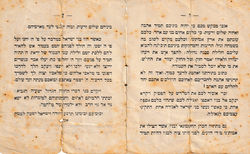 R' Pergola's Address.6,7"I ask you to maintain camaraderie and friendship among yourselves and avoid strife...Help each other to bear the load...Like Yaakov our father gathered his sons to be one group...and Matityahu before his death charged his sons to be at peace with each other...May G-d guard your going and coming...and in the words of Isaiah 'They shall beat their swords into plows...'. | 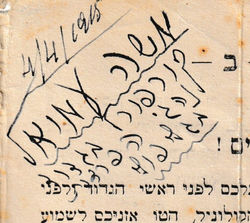 Pergola.Zion Mule CorpsThe booklet has a notation on the inside: 4/4/1915 .. Moshe Emanuel .. Corporal in the Zion Mule Corps .. at Gallipoli. |
 Zion mule corps medaletThis little medalet (24 mm) bears the symbol that has been associated with the Zion Mule Corps. Perhaps it was a pendant or keychain distributed to participants. |  On Active Service in the SinaiBritain decided that to control the Canal they needed to control all of the Sinai Peninsula. This Sinai Campaign stretched through the months of 1916 and stagnated at Gaza during 1917. A British soldier sent this card home in July '17. It pictures a Canal- crossing at Ismailia. He reports 'All is well". |  OAS.Sinai.el Arish26 Sept 1917. Between the 2nd and 3rd battles of Gaza this British soldier wrote home 'I was here last February', referring to the town of El-Arish in eastern Sinai. A rather primitive and desolate scene. |
 Battle of Beer ShevaAlong with Gaza, British forces had to conquer Be'er Sheva, which was strongly defended by Ottoman and German troops. The battle took place on 31 October 1917 and under the leadership of newly assigned General Edmond Allenby, they prevailed. This card pictures Ottoman cavalry at the outskirts of Be'er Sheva. |  Germans in Beer ShevaGerman forces and commanders helped to defend Be'er Sheva. This envelope was mailed through the German field post system at Bir-Es-Seba (as the postmark reads) on 3 February 1917, to Berlin. On the front and back it shows the imprint of the 'German Field Hospital' and a signature that may belong to the censor. The German/Ottoman forces were defeated in October. |  German troops in Be'er ShevaThis envelope was mailed through the German field post system at Bir-Es-Seba (as the postmark reads) on 7 August 1917, to Werdau in Saxony. The envelope was specially printed for soldiers with the word ‘Fieldpost’ in a red box. In addition to the field post cancel in the upper right, there is the imprint of the ‘Imperial German Telegraph Service’ in the lower left. This field office functioned from 6 October 1916 until 1 November 1917. |
 EEF.stampsAfter their successes in Sinai and Southern Palestine, the British officially occupied Palestine. Their army was known as the Egyptian Expeditionary Force - EEF. They issued postage stamps in February 1918. 1 Piastre paid for mail abroad and when overprinted '5 Milliemes' was used for more local mail. This little card used such a stamp to reach Cairo. There is no message, just a picture of a hotel in France. Mailed 1 July 1918. Note 'EEF' in large letters at the top of the stamp. |  Jews in the EEFJews, including many from Palestine, were soldiers in the British 'Egyptian Expeditionary Force'. These two in uniform had their picture taken and printed as a postcard. They look young! On the back in Hebrew: 'A memento for my brother Yitzchak when we were in the 'Egyptian Force' Shimon. 11 August 1921 Lod (Lydda).' Next to that 'Yitzchak Katz Zichron Yaakov'. |  French Garrison JerusalemFrance also had troops in the Middle East. They shared in defense of the Canal. Others fought under British leadership in Palestine. This card pictures a Christian chapel in Jerusalem. On the back is stamped in French: 'French Garrison Jerusalem'. The French assumed that their participation would win them a share of Palestine. Actually, they got Lebanon and Syria instead. |
 French High Commission in PalestineThe Sykes-Picot agreement France made with Britain in 1916 includes them. However in December 1918 they conceded any control to Britain, and were satisfied with control of Lebanon and Syria. So what started as an ‘International Administration of Palestine’ ended up as the British Mandate of Palestine, authorized by the League of nations. This card was written before the concession, in July 1918 in Jerusalem. It bears the French imprint “High commission of the French Republic in Palestine |  French Theatres of War medalThe French were most involved in/near France on the Western Front. They also participated at the Suez Canal, Palestine, the Balkans, West Africa, and Romania. This medal lists 8 western battles, Macedonia (Balkans) and Palestine. The front shows a soldier crowned with a wreath and above the inscription "Victor". |  Italian forces in JerusalemItaly wanted to participate in the land forces, and hoped to gain a share of territory if & when the Ottoman Empire was carved up. They were permitted to send 500 infantry. This card, picturing Jaffa Gate and mailed 8 July '17, is imprinted 'Italian Detachment of Palestine Command'. Mailed to Lyon France 'From the Palestine front'. |
 Indian troops in JerusalemTroops from India were a significant part of British forces in WWI. Many were sent to the western front. Others were at the Suez Canal. The Indians were 2/3 of Allenby's forces conquering Palestine, altogether some 95,000. They were decisive in capturing Haifa, Beirut, Tripoli and Aleppo. This card shows them riding by the walls of the Old City in Jerusalem. |  German and A-H Expedition.JerusalemMailed 3 June 1916 from Aleppo Syria but written in Jerusalem and picturing Damascus Gate. The rubber-stamp reads 'The First Expeditionary Corps for German and Austro-Hungarian Army in Jerusalem'. |  Germans in JerusalemThis card picturing Tiberias was mailed from Jerusalem to Bottrop, Germany 24 March 1917 by a German soldier. The postmark reads 'Feldpost.Military Mission.AOK4'. That is the number of the 'Army Higher Command'. Austrian troops also operated under German command in supporting the Ottoman defense efforts. |
 KUK in JerusalemKUK stands for 'Royal and Imperial' and precedes descriptions of the Austro-Hungarian government and in this case armed forces. This card's Field postmark reads 'Jerusalem' and is dated 15 October 1917. The sender is part of the Artillery division. The photo shows Arab children at play. |  KUK.Jerusalem.HospitalThis card was mailed 16 January 1917 by a Hungarian soldier in Jerusalem. According to the rubber-stamp, he is either a patient or a worker at the 'Mobile Reserve Hospital in Jerusalem'. The photo pictures a fountain on the road to Jericho. |  KUK.Tiberias.Kanon.TurkeiSomeone mailed this card from Tiberias on 21 May 1919 according to the dateline, to Zagreb Croatia. The unit is the 'Austro-Hungarian Artillery Battery in Turkey'. The war was over months before but this card was still available and seems to have gone through military post. |
 Austrians at KotelThis well-known photo shows Austro-Hungarian Jewish soldiers praying at the Kotel - the Western Wall of the Temple Mount in Jerusalem. A later photo shows the Jews in the British regiments doing the same thing in the same place. Brother against brother. |  Austrian Recruitment in Tzefat***** |  Ottoman Recruitment in PalestineUnder the Empire, Jews had not been welcomed into the Ottoman army and instead paid an exemption tax. Revised policy in 1909 & 1914 obligated most men aged 18 & up. This page was included in Herut (a Sepharadi newspaper in Jerusalem). It lists nearly 300 names, almost all Sepharadi, and calls on them to appear the next day at the military office near the Lions Gate (in Old Jerusalem), with identity papers, or else be considered escapees and suffer the consequences. 1915 or 1916. |
 Ottoman Recruitment continuedThe names appear to be listed according to year of birth. Moslem 1299 corresponds to 1882. Many of the names are from well-known families, such as: Gagin, Valero, Casuto, Elbaz, Pinto, Navon, Pereira, Elyashar... |  Ottoman.Recruitment Rules | 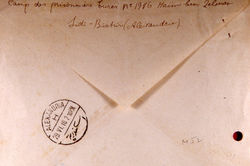 Ottoman Jew POW in Egypt.backHaim ben Zelman is being held in a British POW camp in Sidi Beshir Egypt. He is a Jewish soldier fighting in the Ottoman army. He sent this letter from there on 29 June 1918 to Alexandria. |
 Ottoman Jew POW in EgyptIt is addressed to Mr. Glouskine, director of Carmel Orientale (wine company) in Alexandria. That office was active in helping Jews who found themselves in Egypt on account of the war. It is stamped 'Prisoner of War Camp' and 'Free' because such mail was delivered at no charge. Some of these prisoners actually joined the Jewish Regiments in the British Army! |  Shivat ZionFrom Dec. 1914 to Sept. 1915 the Ottomans deported to Egypt over 11,000 residents who had non-Turkish citizenship. David Idelovitch, head of the Carmel oriental office there, assisted these refugees. This envelope was sent to his office under the name of his welfare effort 'Shivat Zion' (return to Zion). Dated 6 August 1918 and sent through the British army post office, registered, and censored. |  Battle of Petah TikvahPetah Tikvah served as a refugee town for residents of Tel Aviv & Jaffa, following their exile by the Ottoman authorities since they refused to serve the Ottoman army to fight the invading British forces. The town suffered heavily as it lay between the Ottoman and British fronts during the war. "This is the village we captured and are now billeted in. We did blaze away … but were lucky not one man killed", writes a British soldier on the back of this card. Today Petah Tikvah is a major city. |
 Jabotinsky.38th R. FusiliersThe Zion Mule corps was disbanded in May 1916. Trumpeldor, and Vladimir Jabotinsky continued to lobby for a Jewish force in the British army, while serving in other regiments. In August '17 a Jewish battalion was officially announced. It was the '38th Battalion of the Royal Fusiliers', made up of Mule Corps veterans, British volunteers & Russian Jews. This envelope is addressed to Jabotinsky in that battalion. |  39th Royal FusiliersThe 39th Battalion was created in Nova Scotia in April 1918. It was made up of recruits from Canada and the United States. This card was mailed to that battalion, stationed in Egypt, in Kislev 5679, the Fall of 1918. Its address includes the name 'Palestinian Detachment', referring to the Jewish unit. |  Legion.40th BattalionThe 40th Battalion was made up from thousands of volunteers in Palestine. It included some Ottoman Jews who had been captured. Due to delays and training, they missed most of the war. This envelope sent registered from 'Levine & Gelerman' in Kovno, arrived in January 1920. |
 40th Battalion.LadinoThe 40th Battalion was made up of volunteers from Palestine, including some Ottoman Jewish prisoners! These battalions fought in the Jordan Valley and in the Battle of Megiddo. Sent 3 December 1919 from Constantinople by a Sephardic Jew who made notations in Ladino in the corner. 'On Wed. I faithfully put this letter in the post'. A Turkish son fights for Britain! |  J Legion POW EgyptThis envelope is also sent to a soldier in the 40th Battalion. His name is Goodman. It is addressed to 'POW Camp' but if he were a prisoner of the Ottomans, he would be held elsewhere, not in British controlled Egypt. Perhaps this soldier guards/works in the POW camp. | 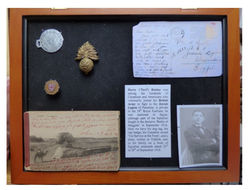 Reisler frameHarry Reisler was among hundreds of Canadians and Americans who joined the British army to fight in the Jewish Legion. Here is his dog tag, Royal Fusiliers cap badge, Canadian service medal, and a diary in Yiddish. He wrote it on a book of Egyptian postcards (where he was stationed) dated 23 - 28 September 1918. |
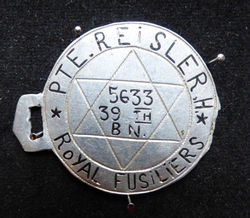 Legion Dog TagThis is Harry Reisler's 'dog tag' (army I.D.). It looks hand made. It shows him to be a soldier in the 39th battalion of the Royal Fusiliers, # 5633. The six pointed star suggests a Jewish affiliation. Although stationed in Egypt, they did fight in the decisive 'Battle of Meggido' in September 1918. |  Jewish Legionnaire in UniformThis Jewish Legion soldier had his photo taken in a studio, wearing his uniform. Essentially a British Middle East uniform, it has two telltale signs: the round Star of David patch on his shoulder, and the 'Kadima' menorah symbol on his cap. |  Legion Uniforms |
 Legion Uniforms and InsigniaThese men are wearing the British uniform. Noteworthy is the patch on their shoulder - an embroidered Jewish star. They also wore the insignia of the Royal Fusiliers. David Ben Gurion, in the center, was a member of the 40th battalion. | 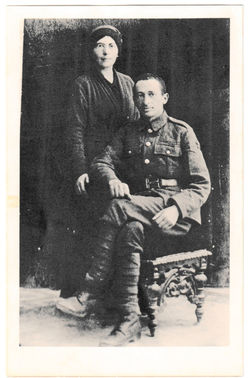 Ben Zvi.Legion UniformYitzchak Ben Zvi (1884-1963) was another prominent Israeli leader who had served in the Jewish Legion. He made Aliyah from Russia in 1907 and continued Zionist activities. His wife Rachel Yanait stands next to him as he wears his uniform. In peacetime he researched 'oriental' Jewish communities including Samaritans and Karaites. Ben Zvi served as Israel's second president starting 1952. |  Grandpa of the LegionIsrael Rosenberg of Philadelphia USA actively recruited men for the Jewish Legion in March 1918. This started the recruitment effort that became the American Hebrew regiment. While in Egypt he organized a �‘Veteran Regiment’. They subsequently joined the 38th battalion of Royal Fusiliers, under Colonel Patterson. Pictured here in his later years wearing his original uniform, he was known as the ‘Grandfather of the Jewish Legion’. |
 Legion Stationery.ChaplainThe three fighting units of the Jewish Legion are the 38th, 39th, and 40th, battalions of the Royal Fusiliers. R' Laib Aryeh Falk, chaplain to the Jewish Legion, wrote this letter on the 38th battalion stationery, to R' Kook with whom he had studied in Kovno. He welcomes R' Kook back to Palestine, as he had been stuck in England during the war years. The 38th was composed of British Jews, including Russian immigrants. R' Falk came with them from England. |  Colonel John PattersonColonel John Paterson was a veteran officer from Scotland. A devout individual, he was very supportive of the Jewish troops and their cause. He is pictured here in his tent as commander of the Jewish 38th Battalion Royal Fusiliers. |  38th Battalion Lines Up in SinaiThese cards are part of a series commemorating the Jewish troops in the War. This is #2 and reads 'Changing of the Guard at El Arish'. |
 Jewish Legion.Shabbat PrayerA similar card pictures Jewish troops at prayer, 'In the field'. According to the caption, it is Shabbat prayer. It seems that two are leading while the majority are standing and listening. | 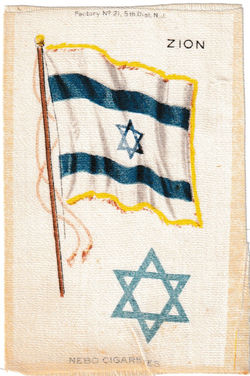 The Jewish FlagThis became the Jewish flag associated with the Jews of Palestine. It was shown in recruitment posters and later was adopted by the Zionist movement, the Jewish Brigade in WWII, and the State of Israel. The stripes called to mind the Talit, the blue symbolized the blue strand of Tzizit. The 'Star of David' was an ancient and even Moslem symbol but was adopted by the Zionist movement at the first Zionist congress. This silk piece was one of a series given free in a box of cigarettes around WWI. |  Jewish Legion.stationery***** |
 Jewish Legion 50th AnniversaryStruck in 1967 for the 50th anniversary of the Legion's founding. Jabotinsky in uniform appears on the front. The reverse shows the insignia that were worn on the uniform. |  Jewish Regiments at KotelHere are Jews from the Palestine British regiments, at the Kotel. Some are holding Siddurim. Some local sages and children have joined in the picture. Their 'enemies', Jewish soldiers in the Austrian army, stood in the same spot previously, no doubt saying similar prayers. |  Ottoman Surrender of JerusalemThe British encircled Jerusalem on December 8th. The next day city leaders surrendered. Walking beneath a white flag of surrender were the mayor of Jerusalem, Hussein el Husseini (with the walking stick and cigarette) & the chief of the Jerusalem police (at the far left). They bore a letter of surrender from the Ottoman Governor Izzat Pasha. |
 Victorious Allenby Entering Old CityOn 11 December General Allenby entered the Old City of Jerusalem through Jaffa Gate, representing the victorious British forces. Meaningfully, it was the beginning of Chanukah. Jews felt liberated from 400 years of Ottoman rule. Horseman Allenby purposefully entered on foot, showing his respect for the Holy City. This color plate is part of a set about the War. |  Allenby Declares Martial LawAllenby took over Jerusalem on December 11, 1917. He walked into the Old City, stood with his entourage at the Citadel, and declared Martial Law, also granting freedom to all the religions there. This postcard preserves that image. | 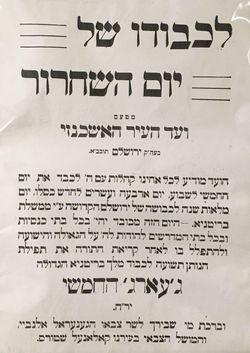 Jerusalem Independence DayPosted in the streets of Jerusalem: "Honoring the day of Liberation...All congregations should observe the 24th day of Kislev the day of Britain's conquest of Holy Jerusalem...Give thanks to G-d...recite the prayer for the welfare of King George the 5th, and praise General Allenby and Colonel Storrs." |
 Commemorating Jerusalem's LiberationThe British conquest of Jerusalem from Ottoman rule was seen as Liberation by the Jews. The 9th of December was observed as a special day in subsequent years. This card was issued by the office of the High Commissioner Herbert Samuel inviting attendance at a reception in 1921, at which decorations for valor would be awarded. Yehudah Altman was the invitee and the card reads 'Press' in the upper corner. Dress is either uniforms or 'morning dress'. |  Aaronson Feinberg****** |  First Judeans StationeryAfter the hostilities ended, the Jewish units were re-named the 'Judean Regiment - Hagedud Ha'ivri'. The battalions were 5000 strong but were soon demobilized, leaving only several hundred on active duty. The Jews called them 'The first Judeans'. Their symbol was a menorah under which read the word Kadima - Forward. Sent 18 August 1920. |
 First Judeans.letter.to NinaThe letter also carries the insignia of the First Judeans. Writing to Nina Berligne, Sargent Kahan, on active duty complains that soldiers are being demobilized, his comrades are leaving, and they can't re-enlist even though they are willing to. Part of the Jewish motivation for fighting was to develop a military for themselves. The British did their best to discourage that. |  Nurses in Jewish Legion.NinaThis group of ladies served as nurses to the Jewish Legion. 2 sisters, Nina and Bella Berlin are among them. Numerous letters, from Jabotinsky and other soldiers, were sent to them, the previous one when they were in Switzerland. This note releases them from service. |  First Judeans.MedaletDesigned locally by the Bezalel Art Institute, this medal was presented to Jews joining the British forces in 1918. The front is a revision of the ancient Roman Judea Capta coin. Here Judea throws off her chains & the Roman runs. The legend reads 'Judea Liberates herself'. The back reads 'To the volunteers' and the date 1849. It's actually not a date but the number of years since the Roman conquest of the Land. In the center are 7 stars, with Hebrew letters that stand for the 6 words of Shema. |
 Legion.Medalet.silver |  Jewish Legion Medalet |  Legion songbookThis songbook was printed for the Americans who joined in 1918. Notice the date - 5678 - but also 1849. Like on the medalet, this number represents the number of years since Jews rose up in battle against the ancient Romans in the First Revolt. |
 Service RibbonThe State of Israel recognized servicemen from pre-State battles. They awarded this ribbon, based on the (then) Zionist flag, to WWI servicemen. It was also awarded to those who served in the Jewish Brigade in WWII. They had marched under this flag. |  KUK to JerusalemAustrian soldier Rosenzweig is in the Austrian army in Europe, with an artillery unit. On 21 August '17 he writes to family in Jerusalem! "My dearest, Thanks to the Almighty we are well and in general not bad off...Greetings and kisses too you and the children". Imagine the emotional conflict of fighting for Germany/Austria while your family is in Jerusalem, among Ottoman, British, Jewish, German and Austrian forces. Hungarian censor mark appears on the front. |  Germany to JaffaThe Beerman family in Grobzig Germany writes to their son Arthur on 21 November 1916. He lives in the brand new colony of Tel Aviv and gets his mail in Jaffa. Notice the Hebrew ב"ה at the top of the card. "We and your sister are thank G-d well. Be glad you are there and living in Menucha (peace !) even if you are missing some things - so are we. You can imagine from your newspapers our situation...Greetings and kisses. Your parents." German and Arab postmarks, and censorship. |
 Templars.InterneeGerman Lutheran Templers established colonies in Palestine starting 1868. The British regarded them as enemy nationals and In 1918 sent 850 of them to an internment camp at Helwan near Cairo in Egypt. In April 1920, 350 of these internees were deported to Germany. Here Gertrud Einsler writes from the camp to her father, a doctor in the medical council of Jerusalem. Army post cancellation of 24 October 1918. They returned in 1923 but were again deported in WWII. |  Templars.internee.messageThis is the German message to Gertrud's father. |  Jerusalem. Have Pity Send MoneyEven before the war began, living was precarious for many families. They lived on donations from abroad or did without. Some identified well-to-do Jews in Europe and regularly wrote asking for donations. This card looks pre-printed. Not dated but before Passover 1914. "Dear Friend...It's Pesach time & I have great expenses...I have a weak & sick wife...Life is unhappy in Jerusalem. Please send money for my situation. I wish you a happy יום טוב ". |
 Ration ticketWorld War One was very hard on the civilian population. They had to contend with opposing armies, often in their towns. Most of the non-pioneering population lived on donations from abroad, but those communities had their own war. There were extreme food shortages & deprivation. A relief committee in Vienna supplied basics to the Jews of Tzefat. This coupon was good for 2 'rotels' of flour in the summer of 1915. |  Wartime Matzah Ration. Tzefat"Aaron Ehrlich and Co. will give to Isaac Engler of Kollel Vizhnitz 3 1/2 rotel of Matzot for the Passover holiday, sent from the heads of the HelpCommittee 1915 in Vienna. It has been paid for'. Four signatures appear below. On the back appears the stamp of the Aaron K"Z Ehrlich company in Tzefat. |  Ration ticket.jerusalem.wallachThis card entitled the bearer to buy one-half rotel of Matzah in the spring of 1915. The process was supervised by the Rabbinic distribution committee. The card is rubber- stamped by Dr. Moshe Wallach. He was head of Shaa'rei Tzedek hospital and well respected and trusted by the old-time religious community to manage this process fairly. |
 ration ticket.Jerusalem.1917***** | 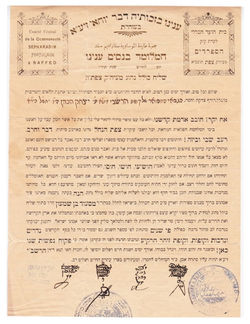 Tzefat.War sufferingThe Sephardic community in Tzefat sent an emissary to North Africa in 1919 to collect funds in the wake of the war. "No one can describe what we have experienced in the days of this terrible war...the orphans are countless, and so are the widows...refugees have lost everything...even earners can't buy their needs due to costly inflation...and who will support those who study Torah in poverty? We beg you to give twice the usual amount...". Signed by 5 rabbis and with 2 community seals. |  Locust BrigadeIf wartime conditions were not bad enough, a severe locust plague broke out in 1915. "The community is being destroyed every day... every minute vine, orchards, vegetable gardens, even houses, by the Locusts... Come out and help, join our crews...the council will provide room and board." Come, Work Save !! |
 Palestine.Kollel note****** |  Palestine check*************** |  Damascus Protocol map******* |
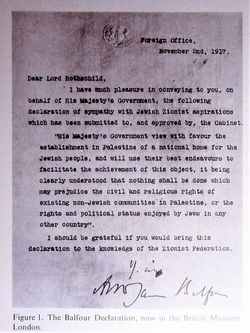 Balfour Declaration******* | 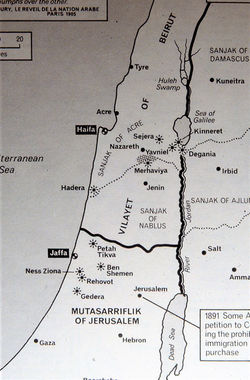 Ottoman map.palestine******* |  Sikes Picot map |
 Katz Medal rosterThis roster lists the soldier and his units. From here we learn that he was in the 40th battalion of the Royal Fusiliers. |  Memorial Service.WWI VictimsThe Mandatory government announced a ceremony for victims of WWI, to take place on the Sabbath. The Haredi community was sympathetic but uncomfortable with this. In this poster, their leader R' Sonnenfeld proposes a special synagogue prayer after Torah reading on that Sabbath. Signed, The Administration of the Ashkenazic Haredi Community. Jerusalem |  In order for a Jewish state to rise. |
 Damascus Protocol map |  Lomzha to BerlinA mother in Europe tries to make contact with her son in Palestine. 2 Sep 1916. "Please relate to my son Shlomo Epstein in Merchavia Palestine café Mezonot that his mother Zippa is back living in Vylodzin / Lomzha, and is expecting help from him". The card was sent to the Aid Committee for German Jews in Berlin which acted as a clearinghouse for such information. The card appears to be half of a reply card. The stamps are German, overprinted for areas they controlled in Poland. |
bottom of page